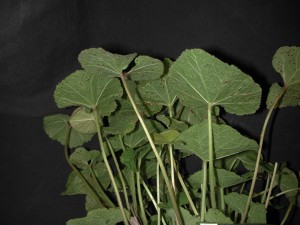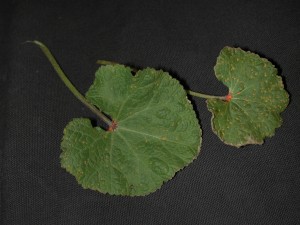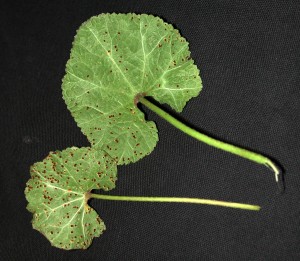Hollyhock rust – Puccinia malvacearum
Pathogen: Puccinia malvacearum
Hosts: Alcea, Althaea, Lavatera, and Malva.
Symptoms: Small brown spots develop on the underside of foliage. Raised, bright yellow or orange pustules are visible on the upper leaf surface. When disease is severe large portions of the foliage are killed.
Spread: Spores can over winter on diseased plant tissues infecting new foliage the following year. Spores are also produced on susceptible weeds these can subsequently infect and cause disease on hollyhocks. Spores are wind dispersed.
Management: Disease control on seedlings is especially important. Fungicide applications at regular intervals are necessary when disease is severe. Plants should be cut back as soon as flowering is done. Plant debris should be removed and destroyed, it should not be composted. Several weeds (in the mallow family) are also susceptible; these weeds should be controlled to limit inoculum in the growing area.



Other Documents in this Series
You Might Also Be Interested In
-
Student-led bird banding innovation spearheads continuation of data collection despite COVID-19
Published on March 16, 2021
-
Creating innovative models to assess spread, possible management of deadly chronic wasting disease
Published on February 1, 2021
-
Improving the health of Michigan’s fishes
Published on February 1, 2021
-
New trail makes nature more accessible at the MSU Corey Marsh Ecological Research Center
Published on August 25, 2021
-
MSU named Top 10 agriculture and forestry college in new report
Published on March 23, 2021
-
MSU students partner with Michigan communities to improve trail access
Published on May 30, 2025
Accessibility Questions:
For questions about accessibility and/or if you need additional accommodations for a specific document, please send an email to ANR Communications & Marketing at anrcommunications@anr.msu.edu.



 Print
Print Email
Email




